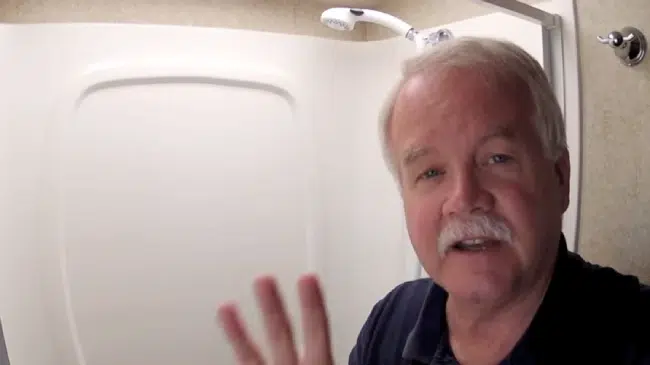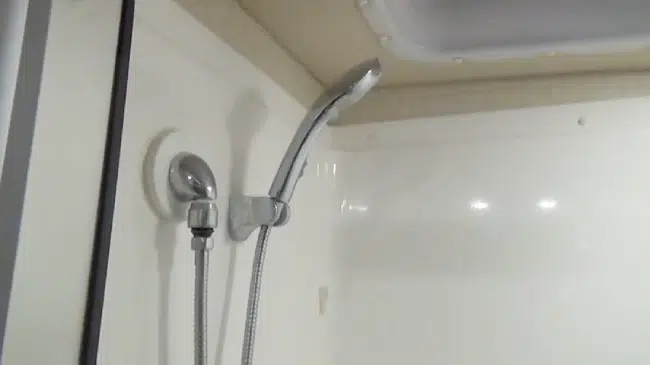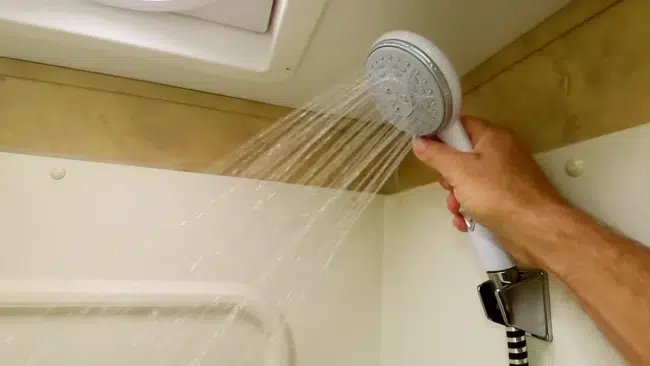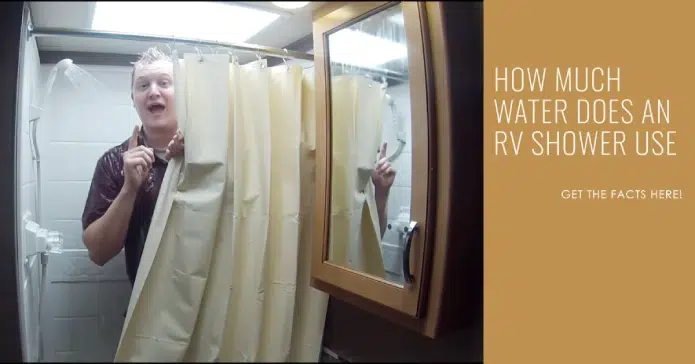Last Updated on September 19, 2023
Are you planning an RV trip and wondering how much water you’ll need for showering? Knowing how much water an RV shower uses is crucial for planning your water usage and ensuring you have enough water for your entire trip.
RV showers consume about 2-6 gallons of water per shower. But this can vary depending on several factors, such as the shower length, the shower head flow rate, and whether or not you turn off the shower while lathering up.
Understanding these factors can help you plan your water usage and ensure enough water for all your needs. Today, we’ll explore the factors that affect water usage in the RV shower and provide tips on how to conserve water during your shower.
What Factors Affect the Water Usage in an RV Shower?

Several factors can affect water usage when taking a shower in your RV. Here are some factors:
Length of Taking Showers
The length of your shower largely determines the amount of water used in an RV shower. You will drain your water tank faster if you spend more time showering.
If you’re trying to save water and extend your shower time, you’ll want to keep your shower as short as possible without sacrificing cleanliness. On average, an RV shower should last no more than 5-10 minutes. This will give you enough time to soap up, rinse off, and feel refreshed without wasting water.
If you take longer showers, try setting a timer or using a low-flow showerhead to help conserve water.
Showerhead Flow Rate
The flow rate of your RV shower head plays a crucial role in conserving water usage. A showerhead with a higher flow rate will consume more water per minute than low-flow or water-saving showerheads. If you have a showerhead with a high flow rate, you may use more water than necessary during your showers.
A low-flow showerhead can reduce water usage without sacrificing the quality of your shower. By decreasing your showerhead’s flow rate, you can save water and, in turn, save money on your water bill.
Personal Showering Habits
You can make a significant difference in water usage by being mindful of your shower habits. This means turning off the water while you lather or shave. By doing so, you can have a major impact on your overall water consumption and help to conserve this valuable resource for future generations.
To further reduce your water usage while showering, consider adopting other habits. For example, try taking shorter showers or installing a low-flow rate RV shower head. Also, conserve water by avoiding unnecessary rinses, such as those taken after washing your hair.
Water-Saving Modifications
If you want to slash your water consumption while enjoying a refreshing shower, try installing water-saving modifications. These modifications can significantly reduce the amount of water used during your shower without compromising the quality of your experience.
Here are some of the water-saving modifications you can install in your RV shower:
- Aerators or flow restrictors: These devices limit the water flow without compromising the shower quality. By reducing the amount of water flowing through the showerhead, you can save a considerable amount.
- Low-flow showerheads: These showerheads are designed to use less water than traditional models. They can reduce water consumption by up to 50% without sacrificing water pressure or shower quality.
- Water-saving toilets: Water-saving toilets use less water per flush than traditional toilets. They can cut water usage by 60%, significantly impacting your overall water usage.
- Pressure-reducing valves: These valves can help reduce the water pressure in your RV shower. Reducing the water pressure can save water and prevent damage to your RV’s plumbing.
How long can I shower in an RV?

Most RVs have a 6-gallon water heater that provides about 8 to 10 minutes of hot water if you run the shower head continuously.
If your RV has a 10-gallon water heater, you can get up to 15 minutes of hot water for your shower. But it’s still recommended to keep your showers as short as possible to conserve water. Take quick and efficient showers to maximize your hot water supply.
How to Conserve Water in an RV Shower?
If you’re looking to conserve water while showering in your RV, there are a few tricks you can follow.
#1 Use the Campground Showers
Using the campground showers will leave you feeling refreshed and ready to tackle a new day of adventure. You’ll save water in your RV and have access to a larger shower space with potentially more amenities than your RV shower can offer.
You won’t have to worry about filling up your water tank as often, so you can spend more time relaxing. But if you prefer to use your RV shower or the campground doesn’t have shower facilities, there are still ways to conserve water.
#2 Install a Low-Flow RV Shower Head
Consider installing a low-flow shower head to conserve water during showers in your RV. These shower heads are easy to find and inexpensive to purchase, making them a practical water-saving solution for RV owners. With a low-flow shower head, taking a refreshing shower is still possible without wasting water.
Some low-flow shower heads also come with a “Pause” feature, which allows you to temporarily stop the water flow while you lather up or shave. This feature can save you even more water during your shower.
#3 Turn Off the Water When Unused
Now that you’ve installed a low-flow shower head, you can take your water-saving efforts one step further. One simple yet effective way to conserve water during your RV shower is to turn it off when it’s not in use.
You can turn off the water flow while you lather up with shampoo or soap and only turn it back on when you need to rinse off. Doing so can significantly reduce your water usage and prolong your freshwater supply.
Here are three benefits of turning off the water when unused during an RV shower:
- It reduces water waste and helps save water for other uses.
- It can extend the life of your freshwater tank and reduce the frequency of tank refills.
- It can save you money on water bills and pump-out fees.
#4 Make a Shower Schedule
Establishing a shower schedule allows everyone to enjoy a warm, refreshing shower and promotes harmony in the family. If you’re living in an RV, creating a shower schedule becomes even more crucial since you have limited water supplies.
Set up a rotation so everyone gets at least one shower every two or three days to save water and create equality. Discuss your shower schedule with your family and decide what time works best for each person.
You can also factor in individual preferences and schedules when creating the rotation. Instead of showering daily, you can use baby wipes to freshen up in between. This not only saves water but also saves time and energy in heating up water for your shower.
#5 Use 2-In-1 Shampoo & Conditioner
You can save time and simplify your shower routine by switching to a 2-in-1 shampoo and conditioner. This makes your hair care regimen more efficient and effective. Besides combining the benefits of shampoo and conditioner, this product also helps you save water.
Rinsing out shampoo and conditioner separately can waste a lot of water, but with a 2-in-1 product, you only have to rinse once. In addition to the water-saving benefits, two-in-one shampoos and conditioners can also be more convenient for RV living.
How many gallons per minute does an RV shower use?

With a High-Flow shower head, an RV shower uses about 1.5-2.5 gallons of RV tank water per minute. If you take an 8-minute shower of continuous water running, you can expect to use 12-20 gallons of water.
Assuming you have an average RV shower head that uses 1.5 gallons of water per minute, you can expect to take a 4-minute shower before running out of hot water. But if you have a low-flow shower head installed, you can extend your shower time by a few minutes.
How long does it take to shower with a 6-gallon RV water heater?
Taking a cold or hot shower with a 6-gallon water heater is a quick and efficient process. You can comfortably shower for about 5 minutes before the water runs out, but this time can vary depending on your showering habits and your RV’s water pressure.
To make the most out of your 6-gallon tank, here are some tips for conserving water during your shower:
- Wet yourself down quickly and turn off the water to lather with soap.
- Turn the water back on to rinse off.
- Use a low-flow showerhead to reduce water usage.
- Consider taking shorter showers to conserve water and extend the life of your water tank.
What is good shower water pressure in an RV?
The sweet water pressure for RV showers is between 40 and 50 PSI, with a maximum of 60 PSI for newer models. This is because the water system in an RV is more fragile than a traditional home’s, and high water pressure can cause damage to pipes, fittings, and fixtures.
Also, excessive pressure can lead to leaks and wastage of water, a precious resource on the road. Investing in a water pressure regulator is essential to maintain the right water pressure for your RV shower.
RV Shower Water Usage: Save Water and Enjoy Your Shower
So, how much water an RV shower uses depends on several factors. The type of RV, the water tank size, the showerhead, and pressure are all important factors affecting water usage in your RV shower.
But it’s safe to say that an RV shower can use anywhere from 2 to 5 gallons of water per minute. When conserving water in an RV shower, there are several tips you can follow.
For starters, take shorter showers, turn off the water when you’re lathering up, and invest in a low-flow showerhead. Also, you can reuse gray water for flushing the toilet or washing dishes.
Showering in an RV can be challenging, especially regarding water usage. But some simple tips and tricks allow you to conserve water and enjoy a refreshing shower.



